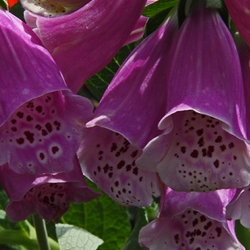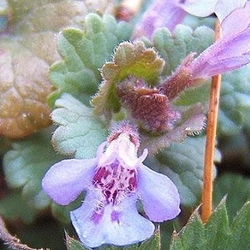(Editor's Note: This article was originally published on April 10, 2008. Your comments are welcome, but please be aware that authors of previously published articles may not be able to respond to your questions.)
When I was two, my mother helped me plant my very own flower garden. I only wanted blue flowers, so she gave me iris and spiderwort to plant. The iris was easy for me, because I only laid it on top of the bare ground and pushed a little soil up around those long funny looking roots. My two year old fingers were a little clumsy with the more fragile spiderwort, but I was determined and I remember digging a hole with a teaspoon, putting a clump of tender little plants in the hole, then being very gentle when I patted the soil over the roots. I do remember being upset because they would not stand up, so my mother poked a tall stick in the soil beside my wilted plants and tied the little things up with string. Believe it or not, with a little water and a little luck, both the iris and the spiderwort grew and bloomed for many years. Later I added bright red bee balm when I decided that red was also my favorite color, and as far as I know the mountain side is still dotted with blue iris, blue spiderwort and lots of red bee balm. That mountain land belonged to my Mom's side of the family, and after the war when my Dad came home we moved about a mile up the road to my Granny Ninna's where I lived until I went away to college and then to a home of my own. It was while living in Granny Ninna's house that I began my journeys with my great Aunt Bett.
Aunt Bett was my Mom's aunt, and she was a true mountain medicine woman. I thought she just had a lot of friends, but I realize now that most of her visitors came for her various cures for whatever ailed them. I was really afraid of Aunt Bett. She was not comfortable with children, and I certainly was not comfortable with her. Why she ever chose me to assist her on her journeys, I don't really know, but I think it might have been because I was the only child available. The houses were few and far apart in the mountains of southeast KY during the 50's. And I was very quiet, of course being scared speechless by Aunt Bett and her magic did diminish the childish chatter considerably.
She was a firm believer in the things she had learned from her mother and her grandmother. Take the asphidity bag for instance. I had to wear the stinking thing so that I would be protected from all harm. Truthfully I was too scared of Aunt Bett to not wear it. To me she was magic, so I thought she might turn me into a toad if I didn't obey her. There is nothing like a little fear of magic to keep a young lady on her toes.
Aunt Bett believed that everything was put on this earth for a reason. She and I differed only in that I wanted flowers to be decorative, and treated them as beloved pets. It bothered me to gather, cut, up root, or de leaf my favorite blooms and I certainly was not going to be eating them for my supper. It was quite unusual to find a little girl who refused to eat a dinner of baked chicken, fried chicken, steak or pork chops during a time when food was so scarce, but I had fed those animals and I had given them names, patted Old Pied (the milk cow) on the nose and hand fed those little peeps when they were just out of the shell. I wouldn't eat eggs either, because believe me, I knew where those little chicks came from. Aunt Bett and I at this point had our first quarrel. She decided it was time to gather spiderwort.
If a plant was to be used for medicine, it was one thing. If its leaf was to add flavor to cooked food, well, that was fine. Getting a leaf plucked off didn't hurt the plant, it was similar to getting your fingernails trimmed, I thought. But Aunt Bett wanted to chop up the entire spiderwort and cook it for dinner! Not in my lifetime, I told her. (There has to be a first time for everything, even saying "NO" to Aunt Bett.) I did go on the spiderwort hunt with her, but that did not mean I was going to make a meal of my favorite flower.
So here is the story of Aunt Bett and my favorite blue Spiderwort, Tradescantia occidentalis. She convinced me that Mother Nature, being a very knowledgeable old lady, would give back to us that which we used for good reason. She said that nature gave us medicines through plants, and as long as we only took our fair share, and left some for regrowth, then we were assured of enough medicine to last our lifetime. Keep in mind, I did believe every word out of Aunt Bett's mouth, because she only said things that were important for me to know. We never wasted time in idle conversation.
Early in the morning while the dew was still on the ground and the sun had barely touched the mountaintop, Aunt Bett and I started out on our journey up the side of the mountain. I carried the big paper sack full of smaller paper sacks and a pair of scissors deep in the bottom of the bag. And I wore the stinking asphidity bag to protect me from the goblins and gremlins, even though it was in early July. Spiderwort grew in clusters on the mountainside very near a running stream. They didn't seem to mind the dappled shade of the trees as long as they were close to moisture. I enjoyed these trips for spiderwort because being beside the stream was beautiful. It made a gentle gurgling sound and it seemed to me it was always a gathering spot for birds and small squirrels and chipmonks. Aunt Bett and I were so quiet, they never seemed to mind that we were in their territory. Going out in the early morning brought some hazardous moments. Though very beautiful in the sunshine, spiderwebs were also spun in the shade, and those weren't so easy to see. Many times I had to stop and disentangle myself from an invisible web that was strung like a clotheline from one tree and on to another. And more often than not, I had to cough and gag from the idea that I might have swallowed a spider. I quickly learned to carry a bandana that I could wave in front of me to clear the way of spiderwebs, but sometimes I just walked a little more closely behind Aunt Bett. We followed the stream till we came to the many clusters of spiderwort. They were very fine, fragile plants and gently fluttered in the slightest breeze. I thought they looked like little ballerinas dancing together in the rays of sunshine. We gathered the spiderwort, me apologizing to the lovely plant with every snip of the scissors, but I did as I was told and true to her habit, Aunt Bett only gathered a few stalks of the plant from each of the clusters. We filled up our bags, and if you are familiar with cutting spiderwort, the juice that comes from the stalk when it is cut is very stringy, much like a spiderweb. I always wondered if that is where they got their name. Gathering spiderwort was a pretty messy endeavor, spiderwebs and spiderwort juice all mixed together made for a very sticky kid. After we filled our little paper bags, and then the big burlap sack with all we needed, we always washed our hands in the little stream that ran cold down the mountain. In the spring I could see tiny fish, sometimes tadpoles in the flatter puddles of the stream. There was always something to be seen.
Gathering spiderwort was a pretty messy endeavor, spiderwebs and spiderwort juice all mixed together made for a very sticky kid. After we filled our little paper bags, and then the big burlap sack with all we needed, we always washed our hands in the little stream that ran cold down the mountain. In the spring I could see tiny fish, sometimes tadpoles in the flatter puddles of the stream. There was always something to be seen.
While we sat by the stream and ate our lunch, this time we had fresh molasses on Aunt Bett's homemade biscuits, she told me of the importance of the spiderwort plant. Seems that it all started with Native Americans who gathered spiderwort for the same reasons that we were gathering it. They also used it for food and for medicine. The young leaves were eaten like salad greens, or mixed with other greens like the dandelion or poke, and fried or boiled till tender. The fresh plant was also mashed and rubbed into insect bites to relieve pain and itching. And from the fresh plant the leaves and the stalk could be mashed into a type of poultice to treat boils and infected skin areas.
We hung most of the plant in clusters to dry on the rafters of Aunt Bett's back porch, along with other herbs and plants she had gathered. Dried and ground, a tea could be made from it to use as a laxative or for other assorted tummyaches and pains. Though I did not know it at the time, the tea was also given to young women to treat menstrual cramps and other associated problems. Aunt Bett also used it to treat kidney infections. She was never hesitant to use the entire cut plant for all these treatments. If you are familiar with spiderwort, the bloom just fades away and disappears into its little green cup if it is picked and receives no more water. Hanging it upside down on the back porch kept most of the juice inside its stem as well, so when it was dried it was still full of nutrients.
We usually made a second trip up the mountain to gather spiderwort one more time before it stopped blooming. This was strictly for the new growth that had started after our first cutting. Aunt Bett did not use the bigger plants or the tougher older stems, she only gathered the tenderest newest offerings, because she said that was the best time for fresh medicine. So once more it was a bittersweet journey to gather this plant. I didn't like cutting the lovely blue flowers only to see them wilt right in front of me, but I did enjoy the trip beside the trickling stream. I didn't like fighting the spiderwebs or imagining spiders in my mouth, but I did enjoy dipping my hand into the creek to grab a handful of that icy mountain water to wash out my mouth. Besides, I had on my asphidity bag, so I knew the spiders and the tadpoles wouldn't really come near me.
I reconciled myself to the fact that Aunt Bett would do as she pleased, and just as I did with the asphidity bag, I might as well listen and learn. Here is Aunt Bett's recipe for spiderwort greens:
"Wash the fresh picked plant. Chop in small bite sized pieces.
Simmer for a few minutes in enough water to cover. Add a pinch of salt.
Drain, throw out water. Sprinkle a little lemon juice over greens. Eat with green onions and cornpone.
Goes down good with a glass of cold buttermilk."
None for me, thank you very much, but I did learn one more surprising thing that I dearly loved to do. I learned to make dye from the sweet blue spiderwort flowers. Eventually Aunt Bett and I planted Spiderwort in my yard and in hers. It was easy to transplant and grew very well for both of us. One warm summer day, she taught me to make blue dye from the freshly picked blue blossoms, and here is that recipe:
"8 cups of water
8 cups of blue flowers, no green
Combine flowers with water and bring to boil, then set away from heat and let set overnight.
Come morning, strain the plant out, and save the blue water.
Dissolve 1 tablespoon alum with 1 teaspoon cream of tarter in a small amount of hot water, and stir into dye. Use a long wooden spoon and be sure it dissolves good.
Add white fabric, soak over nite or till it is as dark as you want.
The alum sets the dye in the fabric and the cream of tarter makes the dye a brighter color and softens the fabric."
Believe me, I dyed everything I had blue. I had blue socks, blue underwear, and any scraps of fabric my mother would give me. That was the only recipe I loved, and I felt much better about Aunt Bett's massacre of my beloved Spiderwort.
Besides, Aunt Bett was magic, and if she could use a flower to turn water blue, that was good enough for me. But I never did eat any Spiderwort.
All photos are from Plant Files. Special thanks to Dave, Zanymuse, Todd Boland, 9kittymom, and frostweed for the use of their lovely Spiderwort pictures.

















